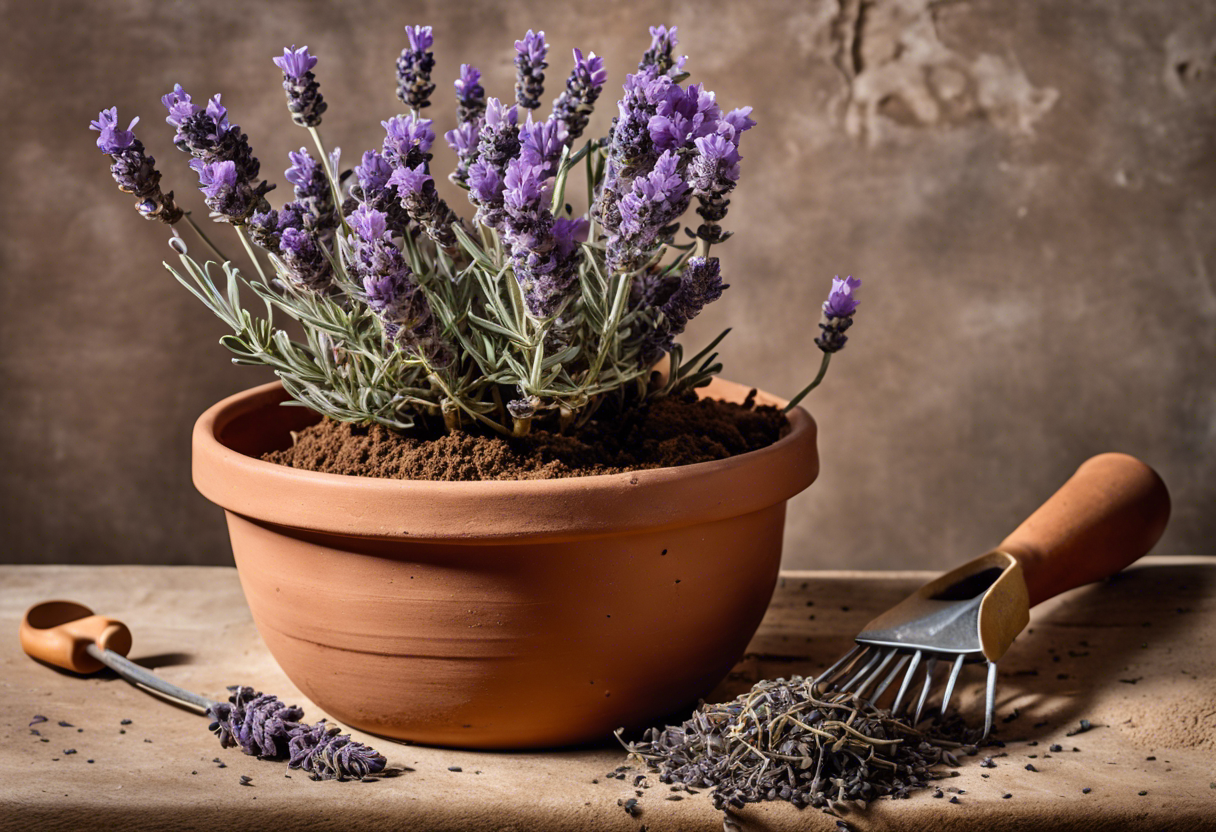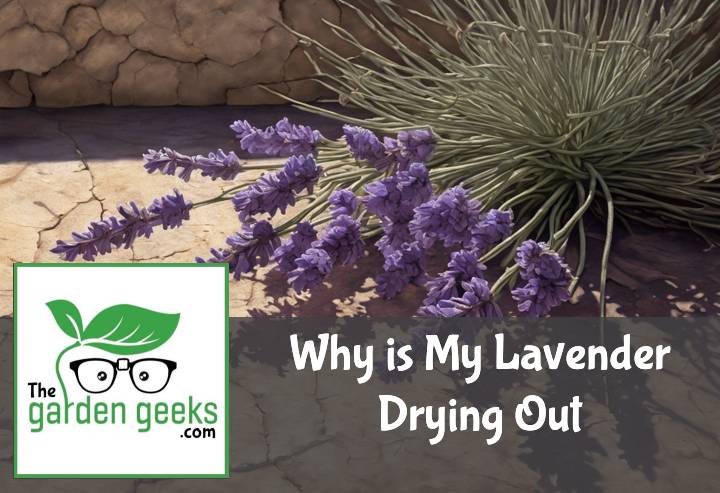Ever found yourself scratching your head and asking, Why is My Lavender Drying Out? Well, you’re not alone! Many of us green-thumbed enthusiasts have faced the same conundrum. Let’s face it, seeing those once vibrant purple petals turn a sickly brown can really put a damper on your day.
But fear not! This post is here to help you get to the root of the problem (pun intended). So strap in, grab a cup of joe, and let’s dive into the world of lavender care. Keep reading about ‘Why is My Lavender Drying Out?’
Key Takeaways
- Lavender plants may dry out due to insufficient watering, overwatering, poor soil drainage, or exposure to extreme temperatures.
- Inadequate sunlight can also cause lavender to dry out as they require full sun for optimal growth.
- Pests and diseases like root rot and fungal infections can lead to drying.
- Correct these issues by adjusting watering schedules, improving soil conditions, ensuring adequate sunlight, and treating any identified pests or diseases.

Understanding Lavender Plants
When you’re scratching your head and asking, “Why is My Lavender Drying Out?“, it’s time to take a step back and get to know your lavender plant a bit better. Let’s start from the beginning, shall we?
The Origin and Natural Habitat of Lavender
Lavender plants originally hail from the Mediterranean region – think sunny Spain, Greece, and Italy. These places offer a unique blend of hot summer sun, cool winters, and well-drained soil – just the kind of habitat lavender loves. This origin of lavender greatly influences its health and growth. If your backyard doesn’t quite match up to a Mediterranean climate (let’s face it, few do), your lavender might throw a bit of a tantrum.
The Ideal Growing Conditions for Lavender
Now that we know where lavender comes from, let’s talk about what it needs to thrive. First off, soil type – lavender prefers well-drained soil with neutral to slightly alkaline pH levels. It doesn’t like wet feet! As for sunlight exposure, this little diva loves basking in full sun for at least 6 hours daily. Watering? Think ‘Goldilocks’ – not too much, not too little. And temperature-wise, remember its Mediterranean roots: hot summers and cool winters are ideal. So if you’re trying to grow lavender in conditions that don’t match these optimal conditions for lavender, it might just be why your plant is drying out!
Common Reasons Why Lavender Dries Out

Ever wondered, “Why is My Lavender Drying Out?” Well, a few common lavender problems could be the culprit. Let’s dive into some common lavender care mistakes that lead to drying lavender plants.
Insufficient Watering
One of the main reasons for your lavender turning into a dry stick figure could be insufficient watering. Under-watered lavender symptoms include wilting leaves and a lackluster appearance. Now, don’t go flooding your plant with water just yet!
Correcting under-watering in lavenders isn’t about drowning them in H2O. It’s about consistent and adequate watering. Remember, lavenders are like those folks at the gym who sip on their water bottles now and then – they need hydration but not a water overload.
Overwatering
Speaking of water overload, overwatering is another common reason why your lavender might be drying out. Yes, you heard it right! Too much love (read: water) can harm your plant.
Overwatered lavender symptoms often mimic those of under-watered ones – wilting leaves and all. But here’s the kicker – overwatered lavenders may also develop root rot which can cause drying out too! The key to correcting overwatering in lavenders is moderation. Think of it as portion control but for plants.
Poor Soil Quality
Another factor that might be causing your lavender distress is poor soil quality. Lavender soil requirements are pretty specific – they prefer well-draining soil with a neutral to slightly alkaline pH level.
Poor soil can lead to malnutrition and stress in your plant, causing it to dry out faster than you can say “lavender”! Improving soil for lavenders involves adding organic matter or compost to enhance its nutrient content and drainage properties.
Inadequate Sunlight Exposure
Finally, let’s talk about sunlight. Lavenders love the sun – they’re like the beach bums of the plant world. Inadequate sunlight exposure can lead to a weak, leggy plant that’s prone to drying out.
Sunlight needs for lavenders are pretty high – they need at least 6 hours of direct sunlight each day. So, if your lavender is stuck in a shady corner, it might be time to move it into the spotlight! Optimizing sunlight exposure for lavenders can make a huge difference in their health and vitality.

Signs and Symptoms of a Drying Lavender Plant
If you’re wondering, “Why is My Lavender Drying Out?“, it’s time to play detective. Look for clues like leaf discoloration, wilted stems, and a slow growth rate. These are classic symptoms of plant dehydration.
Discoloration in Leaves
First up on our list is lavender leaf discoloration. If your lavender’s leaves are turning yellow or brown instead of their usual vibrant green, that’s a red flag. It’s one of the telltale signs of dehydrated plants.
Healthy lavender leaves should be a rich green color. If they’re not, your plant might be sending out an SOS signal. So keep an eye out for any changes in leaf color – it could be the first sign that your drying lavender plant needs help.
Wilted or Drooping Stems
Next up are wilted or drooping stems – another sign that your lavender is feeling parched. Healthy lavender stems should stand tall and proud, but if they’re drooping down like a sad Charlie Brown Christmas tree, it’s probably because they’re thirsty.
A dehydrated lavender plant will have wilted lavender stems, which can make the whole plant look a bit down in the dumps. So if your lavender looks more ‘wilty’ than ‘willowy’, it might be time to check its water levels.
Slow Growth Rate
Finally, let’s talk about growth rates. A slower than normal growth rate can also indicate that your lavender is drying out. Lavenders typically grow at a steady pace – so if yours seems to be stuck in slow motion, dehydration could be the culprit.
Remember: lavenders aren’t tortoises; they shouldn’t grow at a snail’s pace! If you notice your slow growing lavender isn’t sprouting new leaves or flowers as quickly as it should, it might be time to up its water intake.
How to Prevent Your Lavender from Drying Out?
You might be wondering, “Why is My Lavender Drying Out?” Well, it’s all about the care you give. Proper lavender care tips can save your plant from drying out. Let’s dive into the nitty-gritty of preventing lavender drying out and maintaining healthy lavender plants.
Proper Watering Techniques for Lavender
Watering your lavender is a balancing act. Too much or too little water can lead to a dried-out plant. Overwatering can cause root rot, while underwatering leaves your plant thirsty and stressed.
The key is finding the right lavender watering schedule. Generally, lavenders need watering once or twice a week during dry periods. However, always check the soil before watering. If it’s still damp from the last watering, hold off until it dries out.
Choosing the Right Soil for Lavender
Soil selection plays a crucial role in keeping your lavender happy and healthy. The best soil for lavenders is well-draining soil that doesn’t retain too much moisture.
Choosing well-draining soil prevents waterlogging and root rot – two common causes of lavender drying out. Consider soils like sandy or gravelly types which are excellent at draining excess water.
Ensuring Adequate Sunlight for Your Plant
Sunlight is another critical factor in preventing your lavender from drying out. These sun-loving plants thrive under full sun exposure.
Lavenders typically require 6-8 hours of sunlight per day to grow properly. Insufficient light can lead to weak growth and poor blooming – so make sure your plant gets its daily dose of sunshine!
Reviving a Dried-Out Lavender Plant
So, you’re asking why is my lavender drying out and what can I do about it? Well, don’t fret! With some proper lavender plant care, you can revive your dried lavender. The key methods are rehydration and repotting or transplanting.
Steps to Rehydrate Your Plant
First things first, let’s talk about rehydrating lavender. It’s like giving your thirsty plant a big gulp of water after a long day in the sun. Start by watering your lavender plants thoroughly but remember, moderation is key. You don’t want to drown them!
Next up is treating that dry soil. If it feels like the Sahara desert in there, it’s time for some serious moisture control. Adding organic matter or compost can help retain moisture for lavenders and bring back life into the parched earth.
When to Consider Repotting or Transplanting
Now, if you’ve done all this and your lavender still looks like it’s on its last legs, it might be time to consider repotting lavenders or even transplanting them. But how do you know when it’s time?
Look for signs of stressed lavenders – yellow leaves, wilting stems, stunted growth – these are all cries for help from your plant! And if the roots are popping out of the pot holes like an overgrown hairdo? That’s a sure sign of root-bound lavenders.
In such cases, repotting or transplanting could give your lavender a new lease on life. It’s like moving from a cramped apartment into a spacious house – who wouldn’t love that? So don’t lose hope just yet – with some TLC, your lavender can bounce back from its dry spell!

To Wrap Up
So, it turns out your lavender isn’t just being a drama queen craving attention. It’s like a toddler with a fever; it needs care and nurturing to bounce back! The key insights we’ve shared today should help you understand Why is My Lavender Drying Out.
Remember, keep an eye on watering, sunlight, and soil conditions. Your lavender will thank you with its vibrant colors and soothing aroma. Let’s turn those brown thumbs green, folks!


